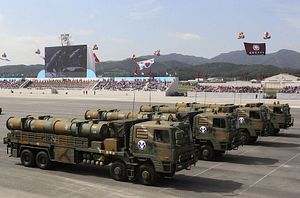South Korea’s military is planning to add an unknown number of Hyunmoo ballistic and cruise missiles to its arsenal to counter the growing missile threat stemming from North Korea, according to unidentified government sources interviewed by Yonhap News Agency.
According to the sources, Seoul is working on a plan to simultaneously eliminate all North Korean missile bases in the event of a conflict. “To accomplish this, the South needs more ballistic missiles at its disposal,” a government official said in August.
South Korea will add new variants of the Hyunmoo (현무, which literally means “Guardian of the Northern Sky”) missile family including the Hyunmoo 2A and 2B ballistic missiles, as well as the Hyunmoo 3 cruise missile—in all likelihood the two latest 3B and 3C variants.
The Hyunmoo 2A surface-to-surface missile has an estimated range of 300 kilometers, whereas the more advanced Hyunmoo 2B—first test-fired in June 2015—has an approximate maximum range of 500 kilometers (310 miles) and is capable of carrying a payload of up of up to 997 kilograms (2,200 pounds).
The Hyunmoo 3B and 3C surface-to-surface cruise missiles have an estimated range of 1000 and 1,500 kilometers (932 miles) respectively. While Hyunmoo cruise missiles have a higher accuracy, the destructive capability of the ballistic variant is substantially greater.
All of the Hyunmoo missiles were developed by the state-run Agency for Defense Development (ADD). As I explained previously (See: “South Korea Tests New Ballistic Missile”):
Ever since 2012, Seoul has been developing a new ballistic missile after the United States and South Korea concluded an agreement to extend the range of those weapons by up to 800 kilometers (about 500 miles) and carry warheads heavier than the pre-2012 limit of 500kg (1,102 pounds).
However, the agreement stipulates that the payload of missiles with a 500 miles range is limited to 1,100 pounds or below, in order to avoid a regional missile arms race with South Korea’s neighbors – China and Japan (shorter range ballistic missiles can carry up to 4,400 pounds under the rules).
Furthermore, I explained that the Hyunmoo ballistic and cruise missiles “will be a pivotal element in South Korea’s burgeoning preemptive deterrence strategy against the North Korean missile threat, based on the ‘Kill Chain’ – an integrated information, surveillance, and strike system, as well as the Korea Air and Missile Defense (KAMD) systems.”
As I noted elsewhere (See: “South Korea to Develop Submarine Launched Ballistic Missile”), Seoul has also been working on a submarine-launched ballistic missile for its burgeoning fleet of KSS-III (aka Jangbogo III)-class diesel-electric attack submarine and other boats. However, up until now, no official test of submarine-launched ballistic missile has been confirmed.
































